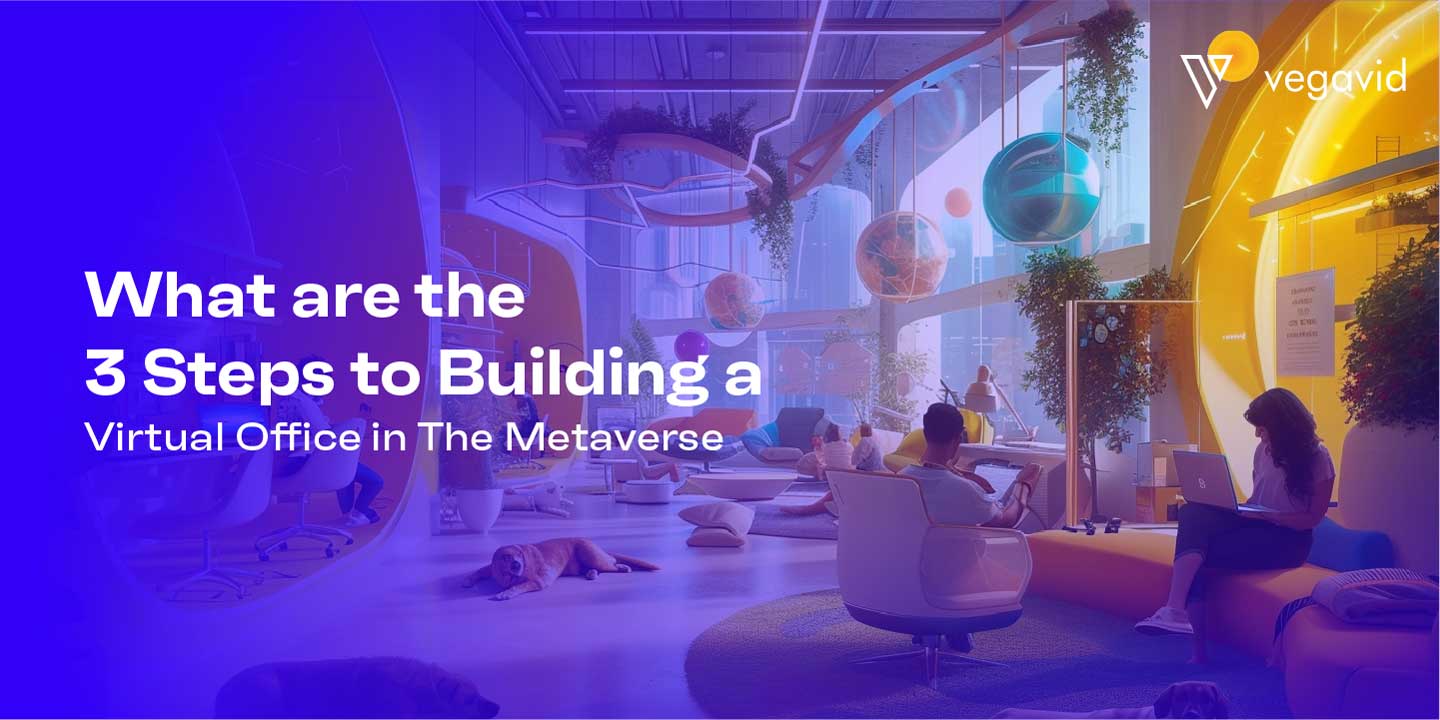
The metaverse opens exciting new doors for working and collaborating in virtual spaces. As technology advances, the lines between physical and digital worlds will continue to blur. This increasingly allows us to work productively from anywhere while still feeling connected to colleagues. Virtual offices within shared metaverse environments aim to improve the remote work experience through more excellent social interactions and a sense of community. By thoughtfully designing virtual workspaces and implementing essential tools, companies can start experimenting with metaverse offices today.
What is metaverse?
The metaverse refers to persistent, immersive virtual worlds that are seamlessly interconnected. It represents the next stage of the internet, where users interact with each other and digital content as embodied avatars rather than disembodied online profiles. Through technologies like VR, AR, and increasingly realistic 3D, the metaverse allows users to work, play, and socialize in interactive digital environments that simulate real-world physics and presence.
The metaverse refers to a collective virtual space encompassing virtual worlds, augmented reality, and other immersive digital experiences. Unlike the internet, which primarily consists of two-dimensional web pages and content, the metaverse is a three-dimensional, interactive environment where users can engage in real-time interactions with others and explore virtual landscapes and environments.
The metaverse represents the next evolution of the internet, blurring the lines between the physical and digital worlds and offering new opportunities for socialization, commerce, and entertainment. As technology advances, the metaverse is expected to become an integral part of our daily lives, revolutionizing how we work, play, and connect with others.
Explanation of virtual offices in the metaverse
Within defined virtual zones of the metaverse, companies can establish dedicated workspaces for employees that replicate key office functionality. This includes communal areas like cafeterias alongside private virtual offices and meeting rooms. Office furniture, decorations, and lighting can be customized to suit company branding or employee preferences. Virtual whiteboards enable remote brainstorming while large screens stream team video calls. More importantly, avatars allow colleagues to interact face-to-face through voice and spatial virtual communication technologies regardless of physical distance.
As the metaverse concept continues to gain traction, virtual offices are poised to play a central role in this immersive digital realm. The metaverse represents a collective virtual space where individuals can interact, socialize, and engage in various activities in a virtual environment. Within the metaverse, virtual offices serve as digital hubs where teams can gather, collaborate, and conduct business in a virtual setting. These virtual offices replicate the functionality of physical office spaces, offering features such as meeting rooms, collaboration tools, and customizable avatars.
Benefits of Virtual Offices In The Metaverse
Virtual offices in the metaverse open valuable new avenues for enterprises embracing hybrid or remote models long term. It strengthens collaboration and culture beyond physical limitations. They enable seamless worldwide interactions from any location. Synchronous projects benefit from universal access to shared documents and presentations viewed simultaneously.
- Casual run-ins and spontaneous idea exchange become naturally supported through social virtual spaces versus fragmented remote communication tools. A shared virtual office may help newcomers integrate into company workflows through interactive onboarding and training opportunities. As presence technologies improve, these metaverse workplaces could finally make remote work feel as energizing as being on-site.
- In today’s rapidly evolving work landscape, virtual offices have emerged as a critical component for businesses striving to adapt and thrive in a digital environment. The shift towards remote work has underscored the importance of virtual offices, offering numerous benefits for employers and employees. One of the key advantages of virtual offices is their ability to transcend geographical boundaries, enabling teams to collaborate and communicate seamlessly from anywhere in the world.
- By eliminating the constraints of physical office spaces, virtual offices promote flexibility and autonomy, allowing employees to achieve a better work-life balance while maximizing productivity. Furthermore, virtual offices can significantly reduce overhead costs associated with maintaining traditional office spaces, such as rent, utilities, and maintenance expenses. This cost-effectiveness makes virtual offices attractive for businesses of all sizes, from startups to multinational corporations.
Moreover, virtual offices facilitate access to a diverse talent pool, enabling businesses to recruit top talent regardless of location. By leveraging technology to create inclusive and collaborative work environments, virtual offices promote diversity and inclusion within the workforce, driving innovation and creativity.
3 Steps to Building a Virtual Office in The Metaverse
In the ever-evolving landscape of remote work, businesses continually seek innovative ways to optimize virtual office environments. As organizations adapt to the challenges and opportunities presented by remote work, experimenting with novel strategies becomes essential. Here, we delve into three virtual office experiments you can initiate to foster productivity, collaboration, and employee satisfaction within your remote team.
1. Crafting and Personalizing Your Virtual Workspace
Companies can empower small teams to experiment freely when designing virtual office prototypes. Provide creative tools to craft customized communal areas and private offices and configure furnishings. Encourage uploading representative avatars while brainstorming ideal interactive layouts and functionality. Iteratively refine spaces based on employee feedback to establish authentic collective identities and productive workflows. This grassroots process cultivates excitement and ownership.
In today’s digital age, the concept of the traditional office space has undergone a significant transformation. With the rise of remote work, the virtual workspace has become the new frontier for businesses seeking to maintain productivity and collaboration. Crafting and personalizing this virtual workspace is crucial for creating an environment that fosters creativity, communication, and efficiency among remote teams.
As we navigate this shift towards virtual work environments, it’s essential to explore ways to tailor these spaces to suit employees’ unique needs and preferences. By incorporating elements that mimic the familiarity of a physical office, such as personalized avatars, customizable backgrounds, and interactive collaboration tools, businesses can cultivate a sense of belonging and engagement among remote workers.
2. Generate employee avatars
Generate memorable avatars as digital identities. Services allow uploading photographs for AI portrait generation or 3D body scanning directly into virtual worlds. From there, customize avatar appearances through outfit, accessory, and expression options. Add name tags displaying real names once comfortable. As people get acquainted through avatars first, ice may break more easily between remote coworkers versus anonymous chat profiles.
One innovative way to personalize the virtual workspace is by creating employee avatars. These digital representations of team members not only add a touch of individuality to virtual meetings and interactions but also help bridge the gap between remote colleagues. Avatars allow employees to express their personalities and preferences in a virtual setting, fostering a sense of connection and camaraderie within the team.
3. Transition your meetings into the virtual office.
Instead of solely relying on 2D video calls, hold optional experimental meetings within virtual office prototype environments using VR/AR headsets or browsers. Configure large screens to stream discussions while encouraging spatial interactions. Brainstorm projects together in virtual whiteboard rooms. Observe engagement levels and refine interfaces based on feedback. Over time, gradually transition to more routine catch-ups and presentations fully online for a richly immersive experience.
With the transition to remote work, traditional face-to-face meetings have been replaced by virtual gatherings conducted through video conferencing platforms. While virtual meetings offer convenience and flexibility, they also present unique challenges in terms of engagement and collaboration. Transitioning these meetings into the virtual office involves more than just replicating the agenda of an in-person meeting; it requires leveraging technology and creative strategies to ensure productive and meaningful interactions.
By incorporating elements of the virtual workspace into meetings, such as interactive whiteboards, virtual breakout rooms, and immersive 3D environments, businesses can enhance engagement and collaboration among remote participants. Additionally, establishing clear guidelines and best practices for virtual meetings can help ensure that objectives are met efficiently and effectively in this digital landscape.
It’s fascinating to see how quickly virtual office concepts take off as interest in the metaverse swells. Early experiments show the potential to keep remote teams seamlessly connected through virtual spaces and enhance collaboration, training, and culture-building compared to isolated video conferencing tools. The COVID-19 pandemic era has accelerated this push toward virtual work dramatically. Many predict hybrid models blending office time with remote flexibility will become the new standard. If so, virtual offices may emerge as the ideal solution to derive the best of both physical and digital workstyles.
Future of virtual office spaces and collaboration in the metaverse
As hardware and virtual world software continue advancing rapidly, the lines between physical and digital are destined to blur further. Within five years, virtual offices may be integrating mixed reality technologies like holograms to simulate physical co-presence. Advanced avatar customization employing 3D body scanning and realistic facial expressions could make digital identities nearly indistinguishable from colleagues on-site.
Emerging haptic interfaces allow interaction with virtual objects using natural touch. And perhaps most exciting, open-air virtual office spaces across stunning digital landscapes may motivate travelers to collaborate ” on location” anywhere globally. The future looks promising for highly social and productive distributed work through virtual offices within richly immersive metaverse environments.
The potential benefits and opportunities of embracing virtual offices in the metaverse. In conclusion, the metaverse opens exciting new opportunities for companies reimagining workflows. Thoughtfully designed virtual offices promise to unite global teams seamlessly while retaining spontaneity and community integral to collaborative success. Early experimentation through essential virtual world platforms available today may yield unexpected benefits worthy of gradually incorporating aspects into daily operations.
Most importantly, an open and positive outlook embracing change leads the way towards harnessing revolutionary software, transforming how we work and live, and connecting Everyone Everywhere. The virtual office’s potential to inspire creativity anytime, anywhere, proves worth exploration as distributed models become the new standard. Exciting times are ahead, indeed!
Final Take Away
As remote and hybrid work models evolve, virtual offices demonstrate the potential to strengthen remote collaboration. It trains employees to experience things like their physical counterparts. Initial experiments allow for refining prototype designs while observing team behaviors to gradually transition aspects of daily operations seamlessly online over time. Various metaverse platforms are actively developing to accommodate such use cases soon. By embracing open-minded experimentation now, organizations benefit greatly as immersive technologies transform how we tie geographically dispersed teams together in the years ahead.











